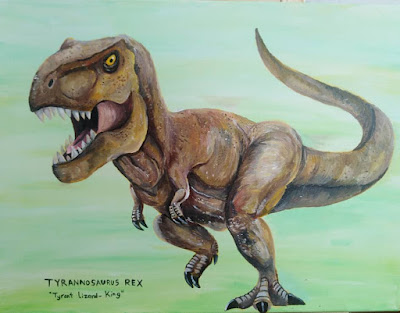FAMISHED FOUR
The painting depicts some of the most powerful carnivorous theropods from the Cretaceous period, namely the Tyrannosaurus, Carnotaurus (bottom left), Giganotosaurus (top right) and Baryonyx (top left). Each of these dinosaurs had different specializations for them to hunt various prey, for example the shape of their teeth and body. Tyrannosaurus possessed over 60 serrated teeth the size of bananas in its jaws, suited to bite at victims and tear flesh. Giganotosaurus, which was larger than Tyrannosaurus, had thinner, serrated, blade-like teeth, however they were not as varied as Tyrannosaurus's, which teeth came in different shapes for different functions. The teeth of Baryonyx were conical and specialized to catch slippery prey such as fish. Carnotaurus, a member of the abelisaurid family characterized by body armor and small arms, probably used its hinged jaws to widen its gape when opening its mouth, enabling it to take a larger bite.
The mountains in the background are based on the layered mountains found in the badlands of the western United States. These were formed from sedimentary rocks, which are the rocks where dinosaur fossils are usually found in. The layers, called rock strata (singular: stratum), are created when particles settle from water or air for millions of years. Generally, older rock strata are situated lower and are stacked by younger rock strata which form over time by water or air particles. These layers can be visible when the formation is exposed through cliffs, quarries or riverbanks. Layering of strata on rock formations can provide a guide for geologists to study the Earth's past.
The Process
The painting was originally made in 2020 and titled "Tyrant Lizard King", only featuring the Tyrannosaurus. The other dinosaurs and background were added later.






Comments
Post a Comment